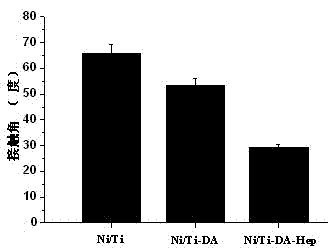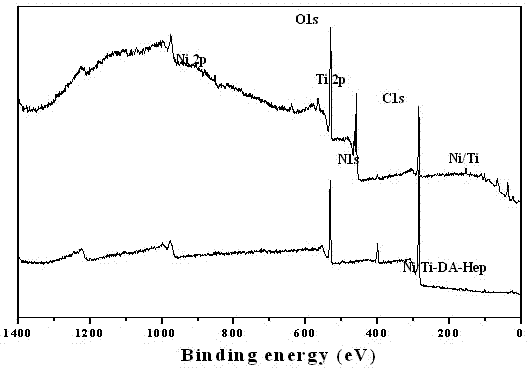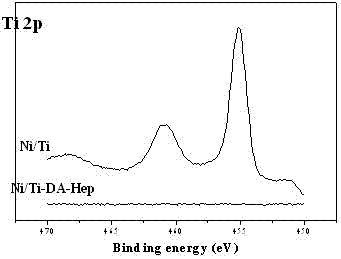Method for fixing functional molecules on biomedical material surface with dopamine serving as bridging
A technology of biomedical materials and functional molecules, applied in the field of bioactivation modification, can solve the problems of loss of biological activity of functional molecules, failure to achieve stable immobilization of functional molecules, etc.
- Summary
- Abstract
- Description
- Claims
- Application Information
AI Technical Summary
Problems solved by technology
Method used
Image
Examples
example 1
[0025] A method for immobilizing functional molecules on the surface of a biomedical material bridged by dopamine, comprising the following steps:
[0026] (1) Soak the nickel-titanium alloy that has removed the oxide layer and surface stains in a buffer solution containing 2mg / ml dopamine, the buffer solution is 10mM Tris-HCl, its pH value is 8.5, soak for 24 hours, and the reaction temperature is 50 o C, then moved to double distilled water and rinsed for 20 minutes, then dried with nitrogen;
[0027] (2) Soak the dried nickel-titanium alloy immobilized with dopamine in a buffer solution with a concentration of 2mg / ml heparin, the buffer solution is PBS buffer solution, its pH value is 7.4, react for 12 hours, and the soaking reaction temperature is 37 o c. Then move to double-distilled water for rinsing for 10 minutes, and finally blow dry with nitrogen to obtain heparin-immobilized nickel-titanium alloy. After assembling the polydopamine and heparin, the DSA10-MK2 surf...
example 2
[0035] A method for immobilizing functional molecules on the surface of a biomedical material bridged by dopamine, comprising the following steps:
[0036] (1) Soak the cobalt-chromium alloy that removes the oxide layer and surface stains in a buffer solution containing 1mg / ml dopamine, the buffer solution is 10mM Tris-HCl, its pH value is 8.5, soak for 24 hours, and the reaction temperature is 37 o C, then moved to double distilled water and rinsed for 30 minutes, then dried with nitrogen;
[0037] (2) Soak the dried dopamine-fixed cobalt-chromium alloy in a buffer solution with a concentration of 2mg / ml heparin, the buffer solution is PBS buffer solution, and its pH value is 7.4, react for 12 hours, and the soaking reaction temperature is 37 oc. Then move to double-distilled water for rinsing for 10 minutes, and finally blow dry with nitrogen to obtain heparin-immobilized cobalt-chromium alloy.
example 3
[0039] A method for immobilizing functional molecules on the surface of a biomedical material bridged by dopamine, comprising the following steps:
[0040] (1) Soak the nickel-titanium alloy to remove the oxide layer and surface stains in the buffer solution containing 3mg / ml dopamine, the buffer solution is 10mM Tris-HCl, its pH value is 8.5, soak for 12 hours, and the reaction temperature is 37 o C, then moved to triple distilled water and rinsed for 60 minutes, then dried with nitrogen;
[0041] (2) Soak the dried dopamine-fixed nickel-titanium alloy in a buffer solution with a concentration of 3mg / ml heparin, the buffer solution is PBS buffer solution with a pH value of 7.4, react for 12 hours, and the soaking reaction temperature is 37 o c. Then move to distilled water for rinsing for 10 minutes, and finally blow dry with nitrogen to obtain heparin-fixed nickel-titanium alloy.
PUM
 Login to View More
Login to View More Abstract
Description
Claims
Application Information
 Login to View More
Login to View More - R&D
- Intellectual Property
- Life Sciences
- Materials
- Tech Scout
- Unparalleled Data Quality
- Higher Quality Content
- 60% Fewer Hallucinations
Browse by: Latest US Patents, China's latest patents, Technical Efficacy Thesaurus, Application Domain, Technology Topic, Popular Technical Reports.
© 2025 PatSnap. All rights reserved.Legal|Privacy policy|Modern Slavery Act Transparency Statement|Sitemap|About US| Contact US: help@patsnap.com



